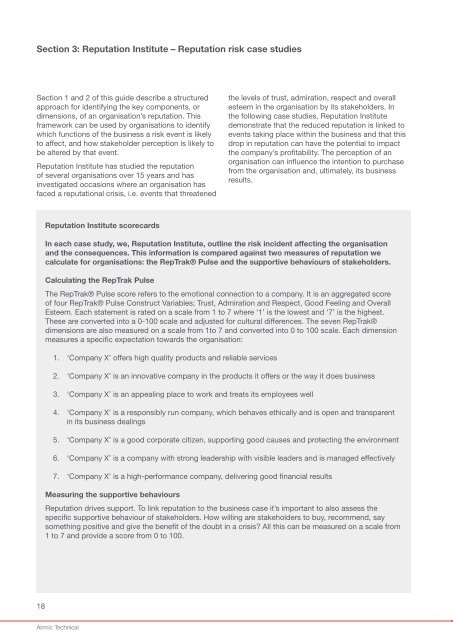Defining and managing reputation risk
TkDn8
TkDn8
You also want an ePaper? Increase the reach of your titles
YUMPU automatically turns print PDFs into web optimized ePapers that Google loves.
Section 3: Reputation Institute – Reputation <strong>risk</strong> case studies<br />
Section 1 <strong>and</strong> 2 of this guide describe a structured<br />
approach for identifying the key components, or<br />
dimensions, of an organisation’s <strong>reputation</strong>. This<br />
framework can be used by organisations to identify<br />
which functions of the business a <strong>risk</strong> event is likely<br />
to affect, <strong>and</strong> how stakeholder perception is likely to<br />
be altered by that event.<br />
Reputation Institute has studied the <strong>reputation</strong><br />
of several organisations over 15 years <strong>and</strong> has<br />
investigated occasions where an organisation has<br />
faced a <strong>reputation</strong>al crisis, i.e. events that threatened<br />
the levels of trust, admiration, respect <strong>and</strong> overall<br />
esteem in the organisation by its stakeholders. In<br />
the following case studies, Reputation Institute<br />
demonstrate that the reduced <strong>reputation</strong> is linked to<br />
events taking place within the business <strong>and</strong> that this<br />
drop in <strong>reputation</strong> can have the potential to impact<br />
the company’s profitability. The perception of an<br />
organisation can influence the intention to purchase<br />
from the organisation <strong>and</strong>, ultimately, its business<br />
results.<br />
Reputation Institute scorecards<br />
In each case study, we, Reputation Institute, outline the <strong>risk</strong> incident affecting the organisation<br />
<strong>and</strong> the consequences. This information is compared against two measures of <strong>reputation</strong> we<br />
calculate for organisations: the RepTrak® Pulse <strong>and</strong> the supportive behaviours of stakeholders.<br />
Calculating the RepTrak Pulse<br />
The RepTrak® Pulse score refers to the emotional connection to a company. It is an aggregated score<br />
of four RepTrak® Pulse Construct Variables; Trust, Admiration <strong>and</strong> Respect, Good Feeling <strong>and</strong> Overall<br />
Esteem. Each statement is rated on a scale from 1 to 7 where ‘1’ is the lowest <strong>and</strong> ‘7’ is the highest.<br />
These are converted into a 0-100 scale <strong>and</strong> adjusted for cultural differences. The seven RepTrak®<br />
dimensions are also measured on a scale from 1to 7 <strong>and</strong> converted into 0 to 100 scale. Each dimension<br />
measures a specific expectation towards the organisation:<br />
1. ‘Company X’ offers high quality products <strong>and</strong> reliable services<br />
2. ‘Company X’ is an innovative company in the products it offers or the way it does business<br />
3. ‘Company X’ is an appealing place to work <strong>and</strong> treats its employees well<br />
4. ‘Company X’ is a responsibly run company, which behaves ethically <strong>and</strong> is open <strong>and</strong> transparent<br />
in its business dealings<br />
5. ‘Company X’ is a good corporate citizen, supporting good causes <strong>and</strong> protecting the environment<br />
6. ‘Company X’ is a company with strong leadership with visible leaders <strong>and</strong> is managed effectively<br />
7. ‘Company X’ is a high-performance company, delivering good financial results<br />
Measuring the supportive behaviours<br />
Reputation drives support. To link <strong>reputation</strong> to the business case it’s important to also assess the<br />
specific supportive behaviour of stakeholders. How willing are stakeholders to buy, recommend, say<br />
something positive <strong>and</strong> give the benefit of the doubt in a crisis? All this can be measured on a scale from<br />
1 to 7 <strong>and</strong> provide a score from 0 to 100.<br />
18<br />
Airmic Technical


